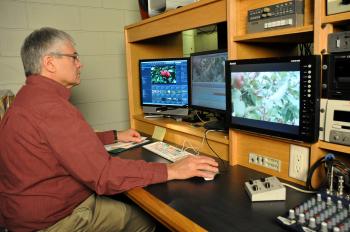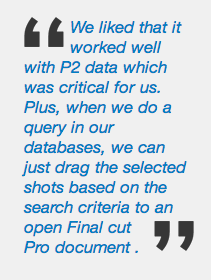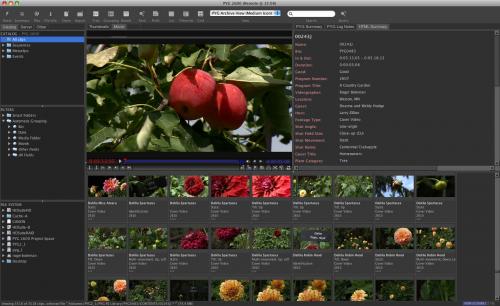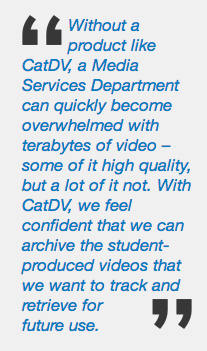CatDV Improves Production at University of Minnesota, Morris
 (Case Study courtesy of Alpha Video)
(Case Study courtesy of Alpha Video)
The University of Minnesota, Morris (UMM) is one of five campuses that make up the University of Minnesota System. Located in western Minnesota, it provides a unique learning environment as an intentionally small, residential university focused on providing an outstanding liberal arts education.
 One of the growing departments on campus is Instructional & Media Technologies. The department has a video production lab with 12 fully equipped workstations where students learn the fine art of video production and editing. More importantly, the department has a complete broadcast studio where many television projects are produced throughout the year directly for broadcast.
One of the growing departments on campus is Instructional & Media Technologies. The department has a video production lab with 12 fully equipped workstations where students learn the fine art of video production and editing. More importantly, the department has a complete broadcast studio where many television projects are produced throughout the year directly for broadcast.
The department produces college promotional videos, documentaries, and research-based video projects, but is probably best known for Prairie Yard and Garden. The program is a weekly gardening program, airing October through April on Pioneer Public Television (KWCM). The program reaches over 375,000 households in west central and southwestern Minnesota, eastern South Dakota and northern Iowa. Prairie Yard and Garden has consistently been ranked as one of the most popular programs on Pioneer Public Television out of its 200 regular scheduled programs.
Moving to File-based HD Video
In 2009, the department started planning to migrate from a tape-based, SD production to file-based HD video. Mike Cihak, Assistant Director of Marketing Communication and Design, said that they knew from the beginning that they would need to replace the cameras and media server. Working with Darren Whitten, Account Executive with Alpha Video & Audio in Edina, MN, the University selected two Panasonic AG-HPx300 broadcast camcorders because they liked the P2 data format. Commenting on the migration, Cihak said, “Within a year of purchasing the P2 cameras, we needed a new media server. The old Apple Xserve only had one terabyte of storage and the HD files were filling that up quickly.”
 Cihak added, “The media server is used by both the broadcast studio for the professional productions and by the students for their lab work. It needed to be write protected and have permission based accessibility so that data could be easily shared among students and faculty.” Working again with Whitten at Alpha Video, the university purchased an EditShare Storage System with 16 Terabytes of storage. “This system gives us user-level management of disk space. All of the media students receive an account and about 200GB of media space. They also have access to the class media space so they can easily share assignment files with the professor. It really makes it much easier to manage the server.
Cihak added, “The media server is used by both the broadcast studio for the professional productions and by the students for their lab work. It needed to be write protected and have permission based accessibility so that data could be easily shared among students and faculty.” Working again with Whitten at Alpha Video, the university purchased an EditShare Storage System with 16 Terabytes of storage. “This system gives us user-level management of disk space. All of the media students receive an account and about 200GB of media space. They also have access to the class media space so they can easily share assignment files with the professor. It really makes it much easier to manage the server.

The Challenge of Tracking Videos
After a year with the EditShare system, the department confronted a challenge that is being faced by many colleges and universities today – how to track the vast amount of HD video being produced. The database they were using to find video on tape would not work for file-based media since each video file is its own record. Based on a recommendation by Whitten, the department evaluated and then selected CatDV software to track, tag, retrieve and archive its digital media. Commenting on the selection of CatDV, Cihak said, “We liked that it worked well with P2 data which was critical for us. Plus, when we do a query in our databases, we can just drag the selected shots based on the search criteria to an open Final cut Pro document. The files are automatically ingested and we can continue editing.”
 CatDV Workflow
CatDV Workflow
Roger Boleman, Director of Instructional and Media Technologies, said, “What sealed the deal for me was the information we received from Whitten and the CatDV people. They answered all or questions and provided a clear demonstration of system integration and workflow. After using the system a number of months, we have realized real savings in personnel time in locating footage through the robust search capabilities of CatDV. It’s evident that this system was developed with video editors in mind.”
The department’s broadcast production workflow begins with shooting the interview and cover video shot on location using the Panasonic camcorders. The data on the P2 cards is brought into the edit suites and copied to the EditShare system into a project space. The P2 data is then ingested into CatDV. As the video is being ingested, CatDV records the metadata assigned to the shot and puts every thumbnail into the database. The department also goes through the clip and assigns additional metadata fields. For example, the Public TV horticulture program uses 40 metadata fields. The staff can define one video clip of a flower blooming by the type of flower, color of the bloom, type of shot, cameraman, etc. Once the editing begins for a program, CatDV is the main search engine for data. As clips are brought into Final Cut Pro, the CatDV metadata fields are automatically dropped into the 15 mapped fields for Final Cut Pro and the clips are assigned to a bin. Once editing is completed, the finished program is placed back into CatDV as a QuickTime file.
Expanding CatDV
At this time, only the broadcast personnel are using CatDV for the professional videos produced for the Public TV programs and to promote the university. Cihak is looking to expand the usage of CatDV to include the high-quality videos now being produced by students in the media classes. Currently, when students leave, their videos leave with them. Commenting on this situation, Cihak said, “The management and tracking of footage shot by students is an issue that many colleges and universities are wrestling with. Without a product like CatDV, a Media Services Department can quickly become overwhelmed with terabytes of video – some of it high quality, but a lot of it not. With CatDV, we feel confident that we can archive the videos shot or produced by students that we want to track and retrieve for future use.”
